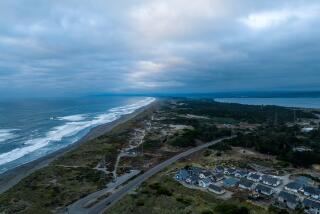O.C. living is going vertical
- Share via
Tom Testa comes home each night to his 12th-floor condo and props his feet onto the sill of a picture window that wraps around his entire home.
The breathtaking view he takes in while sipping chardonnay with his fiancee isn’t Los Angeles or San Francisco; it’s Irvine, part of what used to be Orange County’s flat suburban landscape.
“Everything is within reach,” Testa, 51, said. “It brings a New York way of life to Orange County.”
Last spring he became a pioneer of sorts as the first resident of Marquee Park Place, twin 18-story residential high-rise buildings with views of the Irvine Spectrum, San Joaquin Wildlife Preserve and, on clear days, Catalina Island.
The towers, which had their official opening Thursday, are the first of at least 30 high-rise condo and apartment towers planned or under development in Orange County. The rapidly changing skyline signals the transformation of a suburban landscape.
Scott Bollen, a professor of urban planning at UC Irvine, said the residential towers would “offer citified living in a unique para-urban environment. It means that Orange County is mature enough and sophisticated enough to live in like a city, but at the same time, it’s not Los Angeles.”
The merging of urban living with suburban communities, Bollen predicts, will change how people live and work in Orange County.
“New centers and clusters of activity will give more identity to different places countywide,” he said. “The county will become less and less of a homogenized landscape and more a set of places with unique characteristics.”
Bollen said Orange County joins a few other communities across the country -- including the suburbs of Washington, D.C. -- that can support high-rise living in a nontraditional setting.
So far, Orange County’s high-rise residential housing is concentrated in four cities. Costa Mesa recently approved eight towers, all roughly 20 stories, near the Orange County Performing Arts Center. Anaheim has approved or is reviewing five projects that include towers of up to 30 stories. Santa Ana has eight high-rises approved or under review, including a 29-story loft project. And Irvine has 11 towers already built or under construction near John Wayne Airport.
Several major factors are driving the move toward residential high-rises. Undeveloped land has become scarce countywide, and that which exists is expensive.
Some experts say Orange County’s stock of available open land at the outskirts of developed areas will be gone within the next decade.
“That’s the land used for horizontal communities that are easy to build and for which the county has become famous,” Bollen said.
Now developers are satisfying the need by building skyward on smaller parcels surrounded by existing development.
Another reason for the vertical push: people looking for ways to cut or eliminate their drive to work as freeways clog up for longer parts of each day.
“People are getting fed up with long commutes,” said Sheri Vander Dussen, planning director for Anaheim. “They don’t want to spend hours and hours away from home.”
The commute isn’t the only way high-rise residents are able to simplify their lives.
Security is provided, there are no yards to tend, and there are special amenities not normally associated with traditional condo and apartment environments.
“They prefer a screening room for movies,” Vander Dussen said, “or a common area for visiting with their friends; a space you can reserve for a family party with a large room and big kitchen so you don’t feel like you’re in a social hall.
“Many of these places will be upscale, with valet parking and concierge service; they can basically handle your life for you.”
For this new residential niche to work ideally, planners face major challenges, particularly in ensuring that residents live close to public transportation, retail and entertainment spots.
“There’s a whole lot of planning that has to happen,” said Marlon Boarnet, a UCI professor of planning policy and design, “and if the planning is done, it could work out well. We are literally going into places that had no residences; it’s an exciting moment when planning could make a big difference in the vitality of the region.”
None of which seemed to be on Testa’s mind Thursday as he boasted about the view. “Why wouldn’t you want to live here?”
*
yvonne.villarreal@latimes.com
More to Read
Inside the business of entertainment
The Wide Shot brings you news, analysis and insights on everything from streaming wars to production — and what it all means for the future.
You may occasionally receive promotional content from the Los Angeles Times.











